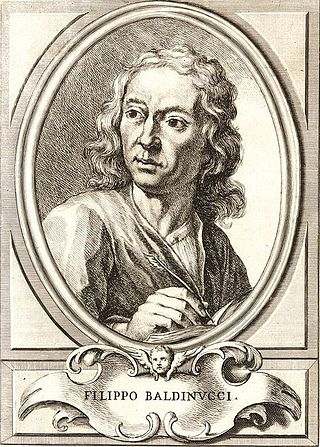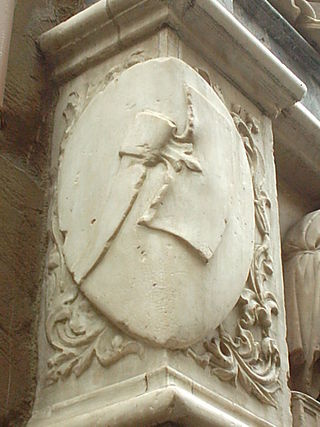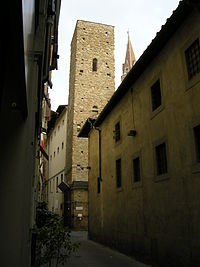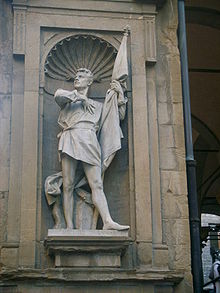
The House of Medici was an Italian banking family and political dynasty that first consolidated power in the Republic of Florence under Cosimo de' Medici, during the first half of the 15th century. The family originated in the Mugello region of Tuscany, and prospered gradually until it was able to fund the Medici Bank. This bank was the largest in Europe during the 15th century and facilitated the Medicis' rise to political power in Florence, although they officially remained citizens rather than monarchs until the 16th century.

Filippo Baldinucci was an Italian art historian and biographer.

Giovanni di Bicci de' Medici was an Italian banker and founder of the Medici Bank. While other members of the Medici family, such as Chiarissimo di Giambuono de' Medici, who served in the Signoria of Florence in 1401, and Salvestro de' Medici, who was implicated in the Ciompi Revolt of 1378, are of historical interest, it was Giovanni's founding of the family bank that truly initiated the family's rise to power in Florence. He was the father of Cosimo de' Medici and of Lorenzo the Elder; grandfather of Piero di Cosimo de' Medici; great-grandfather of Lorenzo de' Medici ; and the great-great-great-grandfather of Cosimo I de' Medici, Grand Duke of Tuscany.

The Republic of Florence, known officially as the Florentine Republic, was a medieval and early modern state that was centered on the Italian city of Florence in Tuscany, Italy. The republic originated in 1115, when the Florentine people rebelled against the Margraviate of Tuscany upon the death of Matilda of Tuscany, who controlled vast territories that included Florence. The Florentines formed a commune in her successors' place. The republic was ruled by a council known as the Signoria of Florence. The signoria was chosen by the gonfaloniere, who was elected every two months by Florentine guild members.

Giovanni Villani was an Italian banker, official, diplomat and chronicler from Florence who wrote the Nuova Cronica on the history of Florence. He was a leading statesman of Florence but later gained an unsavoury reputation and served time in prison as a result of the bankruptcy of a trading and banking company he worked for. His interest in and elaboration of economic details, statistical information, and political and psychological insight mark him as a more modern chronicler of late medieval Europe. His Cronica is viewed as the first introduction of statistics as a positive element in history. However, historian Kenneth R. Bartlett notes that, in contrast to his Renaissance-era successors, "his reliance on such elements as divine providence links Villani closely with the medieval vernacular chronicle tradition." In recurring themes made implicit through significant events described in his Cronica, Villani also emphasized three assumptions about the relationship of sin and morality to historical events, these being that excess brings disaster, that forces of right and wrong are in constant struggle, and that events are directly influenced by the will of God.

The Accademia di Belle Arti di Firenze is an instructional art academy in Florence, in Tuscany, in central Italy.
The Ciompi Revolt was a rebellion among unrepresented labourers which occurred in the Republic of Florence, from 1378 to 1382. Those who revolted consisted of artisans, labourers, and craftsmen who did not belong to any guilds and were therefore unable to participate in the Florentine government. These labourers had grown increasingly resentful over the established patrician oligarchy. In addition, they were expected to pay heavy taxes which they could not afford, forcing some to abandon their homes. The resulting insurrection over such tensions led to the creation of a government composed of wool workers and other disenfranchised workers which lasted for three and a half years.

Jacopo Ligozzi (1547–1627) was an Italian painter, illustrator, designer, and miniaturist. His art can be categorized as late-Renaissance and Mannerist styles.

The Albizzi family was a Florentine family originally based in Arezzo, who were rivals of the Medici and Alberti families. They were at the centre of Florentine oligarchy from 1382, in the reaction that followed the Ciompi revolt, to the rise of the Medici in 1434. They were active members of the Arte della Lana, Florence's wool guild. The Guilds played a central role in the governance of the Republic of Florence during the medieval period and guild members constituted Florence's political and economic oligarchy.

Stradanus, Johannes Stradanus, Jan van der Straet or Giovanni Stradano was a Flemish artist active mainly in 16th-century Florence, Italy. He was a wide-ranging talent who worked as an easel and fresco painter, designer of tapestries, draughtsman, designer of prints and pottery decorator. His subject range was varied and included history subjects, mythological scenes, allegories, landscapes, genre scenes, portraits, architectural scenes and animals. After training in his native Flanders, he left his home country and ultimately settled down in Florence, Italy. He became a prominent court artist to the Medici during the second half of the 16th century and worked on the many decorative projects of the court. Stradanus also produced large altarpieces for the most important churches in Florence.

The Arte della Lana was the wool guild of Florence during the Late Middle Ages and in the Renaissance. It was one of the seven Arti Maggiori ("greater trades") of Florence, separate from the Arti Minori and the Arti Mediane (the "middle trades"). The Arte della Lana dealt in woollen cloth and cooperated with the other corporations of bankers and merchants in administering the commune, both under the podestà and the Republic of Florence. The powerful Albizzi family were prominent members of the guild.

The Arte di Calimala, the guild of the cloth finishers and merchants in foreign cloth, was one of the greater guilds of Florence, the Arti Maggiori, who arrogated to themselves the civic power of the Republic of Florence during the Late Middle Ages. The ascendancy of the Calimala ran from the organization of Florentine guilds, each with its gonfaloniere in the thirteenth century, until the rise of the Medici usurped all other communal powers in the fifteenth century. Their presence is commemorated in the via di Calimala, leading away from the city's Roman forum through the Mercato Nuovo to the former city gate, the Por Santa Maria, as the Roman cardo; the main street, as old as Florence itself, was a prime location for trade, even though, unpaved, crowded, and much narrower than its present state, it was truly a callis malis, an "ill passage-way". The name Calimala is of great antiquity and obscure etymology. Though the original earliest archives of the Arte di Calimala were lost in an 18th-century fire, abundant copies, preserved at the Archivio di Stato, Florence, document the guild's statutes and its activities.

Gonfaloniere of Justice was a post in the government of medieval and early Renaissance Florence. Like Florence's Priori, it was introduced in 1293 when Giano Della Bella's Ordinances of Justice came into force.

The Accademia delle Arti del Disegno is an academy of artists in Florence, in Italy. It was founded on 13 January 1563 by Cosimo I de' Medici, under the influence of Giorgio Vasari. It was initially known as the Accademia e Compagnia delle Arti del Disegno. It was made up of two parts: the company was a kind of guild for all working artists, while the academy was for more eminent artistic figures of the Medici court, and supervised artistic production in the Duchy of Florence.

Orsanmichele's St. James the Major Tabernacle located on the southern façade of Orsanmichele, in Florence, is the tabernacle of The Guild of Furriers and Skinners. The statue of St. James the Major, by Niccolò di Piero Lamberti, once occupied the niche but is now housed in the Museum of Orsanmichele.

The Arte della Seta was the Silk Guild of Florence in the Late Middle Ages and during the Renaissance.

The Arte dei Maestri di Pietra e Legname was one of the Guilds of Florence that represented the Master stonemasons, woodcarvers, and sculptors. It was founded before 1236, and it came to absorb multiple building crafts in the Florence area. It was one of the five Arti Mediani ("middle trades")

The Palazzo dell'Arte dei Beccai or Residenza dell'Arte dei Beccai is a fourteenth-century building in Florence, Italy. It faces the Orsanmichele, once a grain market, later the church of the guilds of Florence. It has had many occupants, including the Arte dei Beccai or guild of butchers from which its name derives. Since 1974 it has housed the Accademia Fiorentina delle Arti del Disegno, an academy of the arts.
The following is a timeline of the history of the city of Florence, Tuscany, Italy.
Caterina Angela Pierozzi was an Italian painter active in Florence in the final quarter of the 17th century, documented as working for the Medici Grand Duchess Vittoria della Rovere, who was well-known for her patronage of female artists. Specialising in miniatures, she was one of only two female artists to be admitted to the Accademia e compagnia delle arti del disegno prior to the 18th century. As it stands, there is only one known extant work by her, a signed and dated miniature on vellum depicting the Annunciation.









































